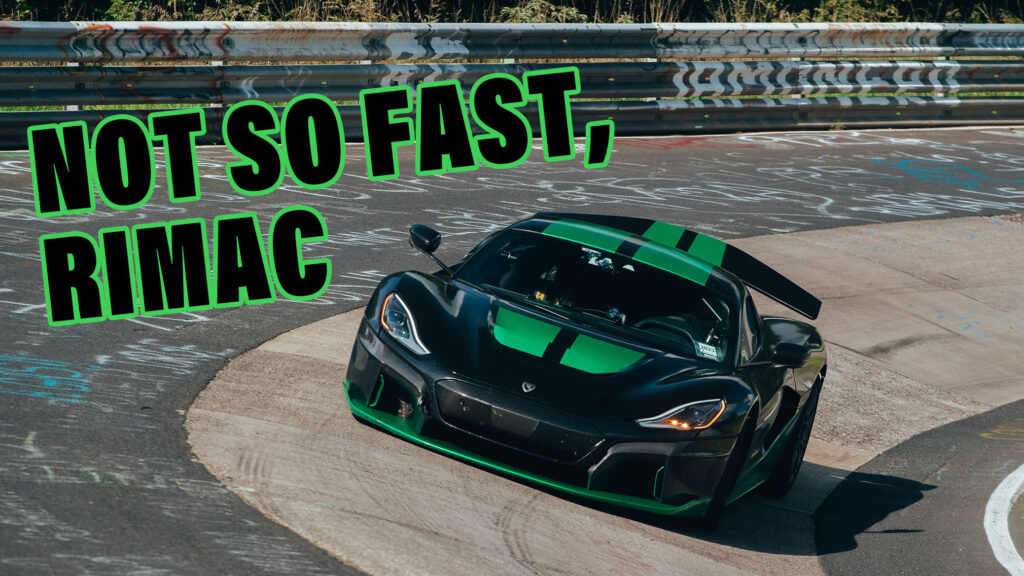Nevera’s seven-minute lap time makes it the fastest EV around the Nurburgring, but it’s still slower than a decade-old Porsche 918 or a 911 GT3 that costs less than a tenth as much
2 hours ago
 –>
–> 
–>
Last week, the Rimac Nevera became the fastest electric car around the Nurburgring Nordschleife, and by some margin. It lapped the 12.9-mile (20.8 km) track in 7:05.298 seconds, demolishing the 7:25.23 time set by the Track Package-equipped Tesla Model S Plaid earlier this year.
Automotive outlets around the world gushed at the news, but is this really the great PR coup many people – including at Rimac – probably believe it to be? Because from where I’m standing, the ‘Ring record only serves to dim the Nevera’s nuclear blast-bright performance halo by reminding us how flawed EVs are as drivers machines.
We’ve all seen the videos. Line up a Nevera against any combustion car, including a Bugatti Chiron or any Ferrari or Lamborghini, and it will annihilate them. The Rimac’s mind-bending stats include the ability to reach 60 mph (96 km/h) in 1.74 seconds, 124 mph (200 km/h) in 4.42 seconds, 250 mph (402 km/h) in 21.89 seconds and a top speed of 256 mph (412 km/h).
advertisement scroll to continue
Maybe Rimac should have left it at that because in telling us how long it takes the Nevera to lap the Nordschleife – a much more complete test of overall performance – it’s revealed that the world’s fastest hypercar is in reality significantly slower than cars costing less than a tenth as much.
Related: Rimac Sets Nurburgring EV Record, Introduces New Nevera Time Attack Edition
[embedded content]
Porsche’s 911 GT3 takes a comparatively glacial 3.2 seconds to reach 60 mph, and a yawning 10.8-seconds to hit 124 mph in PDK form, but even without the RS goodies or the optional Manthey chassis kit it lapped the ’Ring in 6:59,927. It costs $182,900 and has 503 hp (510 PS); the Nevera stickers at around $2.2 million and is packing 1,888 hp (1,914 PS).
More: The Fastest Cars And SUVs On The Nürburgring In 2023
Or look at it this way: the pinnacle of electric hypercars in 2023 is still slower than the pinnacle of combustion hypercars from a decade ago. In the fall of 2013 a Porsche 918 Spyder powered by an 874 hp (887 PS) hybrid-assisted V8 lapped the older, fractionally shorter 12.8-mile (20.6 km) version of the Nordschleife in 6:57 seconds. The Nevera needed 7:00.928 to cover the same distance. Rimac says it’s proud that the Nevera turned in such a quick time when it was conceived with touring comfort in mind, but I’ve driven both the GT3 and the 918 and neither is exactly spartan or uncomfortable. You could daily either if you were rich enough.
Rimac also says in mitigation that it set its record on one of the hottest days of the year in the Eifel mountains, so it’s possible that the Nevera could go faster on a cooler day. But even if it does, it’s not going to get close to the time set by the current production Ring champ, the Mercedes-AMG One, which devoured the 12.9 miles of track in 6:35.183 seconds. That’s over half a minute faster.
[embedded content]
It’s not hard to understand why the Rimac didn’t go quicker than it did. It weighs a shocking 5,071 lbs (2,300 kg) to the 911 GT3’s 3,164 lbs (1,435 kg), and though that still gives the Nevera a better power to weight ratio that helps it haul itself out of corners, it still has a lot more mass to slow down coming into them. Excellent traction and a monster 1,741 lb-ft torque output (2,360 Nm) obscures that handicap in the record-breaking straightline acceleration feats, but is less easy to disguise in a tough environment like the Nurburgring.
None of which is Rimac’s fault. These guys are at the forefront of EV technology, are making use of the best hardware available to them right now and have forced us to reevaluate what we expected from a supercar. But the Rimac team is no doubt also working hard on the next generation of electrical equipment in the longer term, and we know from comments made by chief technology officer Emilio Scervo that in the short term it’s considering a more track-focused Nevera with stiffer suspension and smaller battery to reduce weight.
You just know that Rimac won’t want to settle for merely making the fastest EV. Ultimately, it’ll be after the AMG’s overall crown. So I’ll hold off my congratulations until Rimac takes that scalp – and I have absolutely no doubt it will. But tell us what you think: does being the fastest EV help reinforce the Nevera’s performance reputation, or weaken it?

 <!–
<!– –>
–> 
